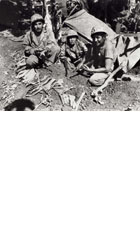
Navajo Warriors: The Great Secret 2002
Distributed by Filmakers Library, 124 East 40th Street, New York, NY 10016; 202-808-4980
Produced by Bonne Pioche -- IDEACOM, Int.
Directed by Michel Viotte
VHS, color, 52 min.
Jr. High - Adult
Native American Studies, Social Studies, World War II
Date Entered: 11/09/2018
Reviewed by Cliff Glaviano, Coordinator of Cataloging, Bowling Green State University Libraries, Bowling Green, OHThis documentary explores the motivations of the Navajos who became Code Talkers in World War II and the Navajos of today who become members of the American armed services. Through interviews with surviving Navajo Code Talkers, historians and experts on the Navajo people, and Navajo Marine recruits, the video provides a compelling argument that Code Talkers and contemporary Navajo men are part of longstanding Navajo warrior tradition that predates white conquest of North America. Much attention is given to the Code Talkers who were especially recruited for service in World War II and who devised the only code in the history of American warfare that was never broken. The code was embedded in the spoken Navajo language that was understood by about 30 non-Navajo individuals at the time of the war. The code involved substituting Navajo words for various military situations, concepts and armaments that did not exist in the Navajo language. For example, the Code Talkers substituted the Navajo word for “bumblebee” for the concept “fighter plane” in developing the code within their language. The code itself was classified top secret and was not declassified until 1969, twenty-four years after the Code Talkers returned to civilian life, thus denying many of these heroes the public recognition they deserved for their part in shortening the war. Recognition in Arizona finally came in 1982 when August 14 was declared Navajo Code Talkers’ Day. Recognition came again July 26, 2001 when President George W. Bush presented surviving Code Talkers with a Congressional medal in honor of their wartime service.
The quality of the audio and video in this production is excellent. Black and white footage and stills from World War II are interspersed with color interviews and spectacular scenes from the Navajo homelands. The photography, editing and sound are also excellent.
This film will enhance Native American and History collections in school, college and university libraries. It is appropriate for discussions on patriotism, the World War II era, and the Navajo people. Though it seems incredible, the Navajo people and their language, so severely suppressed by our government, volunteered to fight for the United States in huge numbers, their language providing the vehicle for the code that served to shorten the course of the war in the Pacific. The war itself brought these Navajo men in contact with 20th century western civilization, while the GI Bill provided the survivors with the education that formed the basis for a Navajo professional class. When asked why he chose to fight the white man’s war, one Code Talker replies, “It wasn’t the white man’s war. It was America’s war, and we’re Americans.” The warrior tradition is alive today.